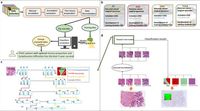Researchers have unveiled a powerful new tool using deep learning to enhance the prognostic assessment of pancreatic ductal adenocarcinoma (PDAC), a highly lethal cancer. By training a convolutional neural network, the U-Net model, the researchers can accurately detect the proportions of tumor, stroma, and lymphocytes from whole slide images, achieving an impressive accuracy rate of 94.72%. This innovative approach clarifies previously ambiguous prognostic indicators, specifically stroma-in-percentage (SIP) and lymphocytes-in-percentage (LIP), both of which have been linked to overall survival in PDAC patients.
Pancreatic cancer is notorious for its aggressiveness and low survival rates, primarily due to late-stage diagnosis. Traditional methods for assessing tumor characteristics have been labor-intensive and subjective, often relegating pathologists to visually estimate tumor-stroma ratios using hematoxylin and eosin (H&E)-stained tissue sections. This new research, published in Scientific Reports, builds on the potential of artificial intelligence to offer more objective assessments.
This multicenter study included 800 histological slides from patients who underwent surgery for PDAC. Data was sourced from several European hospitals, including University Hospital Aachen in Germany and Erasmus Medical Center in the Netherlands, as well as the widely utilized Cancer Genome Atlas (TCGA). The researchers utilized these samples to train the U-Net AI model, capable of classifying specific regions within the slides— tumors, stroma, and lymphocytes— with unprecedented precision.
The study illustrates significant findings: patients with a higher proportion of stroma (SIP) and those with abundant lymphocytes (LIP) often correlated with enhanced overall survival rates. Specifically, survival analysis indicated that those classified with medium stroma and high lymphocyte infiltration had a median survival of 24 months, contrasting sharply with just 12 months for those showing low stroma.
Dr. Lara Rosin, one of the study's authors, stated, "The sight of pathologists assessing histological slides has long needed a technological revolution. Our findings suggest that AI can bridge the gap between cumbersome traditional pathology methods and the future of digital pathology, enabling more accurate prognostication for patients with pancreatic cancer."d
The challenge of evaluating pancreatic tumors lies in their complex microenvironment, which includes not just tumor cells but various supporting cells called stroma fibers, as well as immune cells like lymphocytes. In PDAC, the desmoplastic stroma can impede drug delivery and contribute to treatment resistance, making accurate assessment vital for improving patient outcomes.
This study underscores that high-dimensional imaging, combined with AI, may transform routine clinical practices. Automated analyses can deliver quick results, allowing oncologists to stratify patients more effectively and develop tailored therapeutic strategies. As with all cancer treatments, understanding the role of the tumor microenvironment will remain pivotal in improving treatment responses.
For the findings, researchers employed a unique combination of statistical analysis and image processing techniques. They categorized patients based on their SIP and LIP levels, utilizing tools like X-tile for optimal cut-off determination and Kaplan-Meier survival curves to illustrate prognostic differences. Remarkably, the study found that for each cohort represented, significant distinctions in median overall survival were evident based on the stroma and lymphocyte classification.
The investigative team acknowledges limitations, particularly regarding the potential variability of histological images and slide preparation, and they stress the importance of future advancements in defining more tumor microenvironment features. Building on this research, the team suggests expanding their classification methods to include additional cell types beyond stroma and lymphocytes.
This innovative use of deep learning within the context of PDAC prognosis showed that AI is not only supporting but enhancing the fight against one of the most challenging cancers faced by patients today. As research in this area continues to evolve, the integration of high-dimensional pathology alongside robust computing capabilities promises a more hopeful future for pancreatic cancer treatment and survival.




